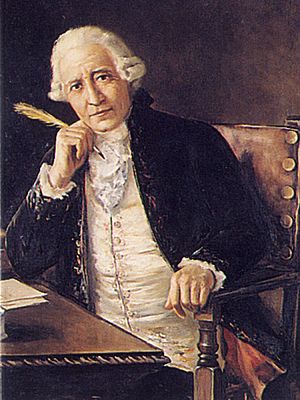Francisco Salva Campillo facts for kids
Quick facts for kids
Francisco Salva Campillo
|
|
|---|---|
| Francesc Salvà i Campillo | |

Francisco Salva Campillo (1900) by José María Marqués y García; tribute paid to him by the Royal Academy of Medicine of Catalonia
|
|
| Born | July 12, 1751 Barcelona, Catalonia, Spain
|
| Died | February 13, 1828 (aged 76) |
| Other names | Francisco Salvá |
| Alma mater | University of Valencia, University of Huesca, Spain, University of Toulouse |
| Parents |
|
Francisco Salva Campillo (in Catalan: Francesc Salvà i Campillo) was an important Spanish scientist. He was born on July 12, 1751, and passed away on February 13, 1828. He was known for his work as a doctor, a physicist (someone who studies how things work in the natural world), and a meteorologist (someone who studies weather). He lived during a time called the late-Enlightenment, when many new ideas and discoveries were made.
Early Life and School
Francisco Salva Campillo was born in Barcelona, Catalonia, Spain. His father, Dr. Jerome Salvà Pontich, was a doctor at the Barcelona General Hospital. His mother, Eulalia Campillo, came from a rich family that worked in pharmacies.
When Francisco was a teenager, he was very smart. The Bishop of Barcelona, Josep Climent, noticed his amazing abilities. The Bishop told Francisco's parents that he should study medicine in Valencia.
Francisco studied at the University of Valencia. He finished his medical course in just three years, which was faster than most students. Later, he earned his doctor's degree in medicine from the University of Toulouse.
Medical Work
Francisco Salva Campillo started a medical school in Barcelona. He wanted to train more doctors. He was very interested in vaccination, especially for a serious disease called smallpox. Vaccination helps protect people from getting sick. He won several awards from the Paris Society of Medicine for his work.
In 1773, he helped start the Academy of Medical Practice. This school is now part of the University of Barcelona. He wanted to bring together practical medical training and classroom learning.
Electric Telegraphy
In 1795, Dr. Salva showed his ideas about "Electricity Applied to Telegraphy" at the Royal Academy of Sciences and Arts of Barcelona. Telegraphy is a way to send messages over long distances using electricity.
Salva showed how electric telegraphy could work. He even thought about sending messages without wires and using cables under the sea. His presentation caught the attention of the government. He was invited to show his telegraph skills to the Royal Family in Aranjuez.
His Legacy
Francisco Salva Campillo died on February 13, 1828. He left behind a huge library. It had more than half a million books about medical topics! He also left money to the Royal Academy of Medicine of Barcelona. According to his wishes, his heart is kept in an urn with his books at the same place.
An artist named Paul DeMarinis was inspired by Salva's work. DeMarinis created an art piece called The Messenger (1998–2006). It explores the ideas of electricity in communication.
See also
 In Spanish: Francisco Salvá para niños
In Spanish: Francisco Salvá para niños

